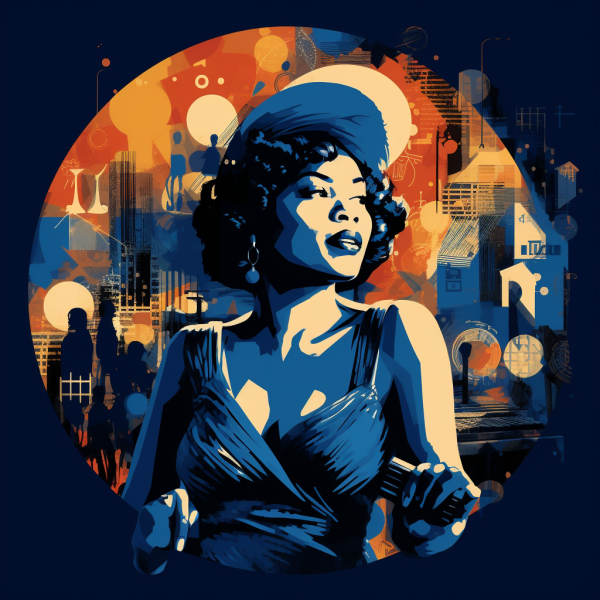The blues, with its raw emotion, soulful melodies, and heart-wrenching lyrics, has always been a genre of music that cuts straight to the core of human experience. While often dominated by male voices, the blues has also seen the rise of powerful and pioneering female artists who not only brought the blues to life but reshaped its landscape. In this exploration of the women who left an indelible mark on the blues, we’ll journey through their lives, music, and the enduring impact they’ve had on this timeless genre.
Bessie Smith: The Empress of the Blues
Bessie Smith, known as the “Empress of the Blues,” stands as one of the most influential and iconic figures in the history of the blues. Born in Chattanooga, Tennessee, in 1894, Bessie faced the challenges of growing up in a racially segregated society, but her talent and determination transcended these barriers.
Smith’s voice was nothing short of extraordinary, with a rich, resonant tone that could convey the deepest sorrow or exuberant joy. Her recording career, which began in the 1920s, saw her collaborate with some of the finest blues musicians of her time, including Louis Armstrong and Fletcher Henderson.
It was Bessie Smith’s songs that often delved into the raw and poignant realities of life, love, and heartbreak that resonated most with audiences. Classics like “St. Louis Blues” and “Nobody Knows You When You’re Down and Out” captured the essence of the blues, with Smith’s vocals delivering a gut-wrenching emotional punch.
But Bessie Smith’s legacy goes beyond her musical prowess. She paved the way for future generations of female blues artists, proving that a woman’s voice could carry the weight of the blues genre with as much power and authenticity as any man’s.
Ma Rainey: The Mother of the Blues
Ma Rainey, often referred to as the “Mother of the Blues,” was another formidable force in the early blues scene. Born Gertrude Pridgett in Columbus, Georgia, in 1886, she was a true pioneer in both her music and her approach to the industry.
Ma Rainey’s influence extended beyond her captivating stage presence and powerful vocals; she was also a trailblazer in navigating the male-dominated world of the music business. As one of the first African American women to record blues music, she helped lay the foundation for future female blues artists.
Her songs, such as “See See Rider Blues” and “Ma Rainey’s Black Bottom,” explored themes of desire, love, and the struggles faced by African Americans in the early 20th century. Her lyrics often featured bold, independent female characters, reflecting her own strong-willed persona.
Ma Rainey’s impact on the blues genre is immeasurable. Her authenticity, resilience, and groundbreaking achievements paved the way for countless female artists who would follow in her footsteps.
Memphis Minnie: The Guitar Pioneer
While many female blues artists of her era were celebrated for their vocal talents, Memphis Minnie (born Lizzie Douglas) made her mark as a trailblazing guitarist. Born in Algiers, Louisiana, in 1897, Minnie was a true pioneer of the blues guitar, a field traditionally dominated by men.
Her intricate fingerpicking and slide guitar techniques were nothing short of groundbreaking. Minnie’s guitar skills added a unique dimension to the blues, earning her recognition as one of the most influential blues guitarists of her time.
Songs like “Bumble Bee” and “Me and My Chauffeur Blues” showcased her exceptional guitar work and songwriting abilities. She was also known for her assertive lyrics, often addressing themes of love, independence, and social issues.
Memphis Minnie’s contributions to the blues genre extended beyond her lifetime. Her innovative guitar style inspired countless musicians, both male and female, and solidified her place in the pantheon of blues legends.
Billie Holiday: The Lady Day
Billie Holiday, often referred to as “Lady Day,” is a name synonymous with both the blues and jazz. Born Eleanora Fagan in 1915, Holiday’s voice was a unique and haunting instrument that conveyed a depth of emotion rarely matched in the world of music.
While she is often associated with jazz, Billie Holiday’s repertoire also delved deeply into the blues. Songs like “Strange Fruit” and “Good Morning Heartache” revealed her mastery of the blues idiom, with its heart-wrenching tales of love and despair.
What set Holiday apart was her ability to infuse her songs with a sense of vulnerability and authenticity. Her life experiences, marked by hardship and adversity, lent her music an unparalleled emotional resonance. Holiday’s voice was a conduit for pain, resilience, and the enduring human spirit.
Her influence extended far beyond her own era, shaping the careers of countless singers who followed in her footsteps. Billie Holiday’s legacy in the blues and jazz worlds remains a testament to the enduring power of music to connect with the depths of the human soul.
Etta James: The Matriarch of R&B and Blues
Etta James, born Jamesetta Hawkins in 1938, was a versatile artist whose career spanned multiple genres, including R&B, soul, and blues. Her powerful and versatile vocals made her a force to be reckoned with in the world of music.
In the realm of blues, Etta James delivered unforgettable performances. Her rendition of “I’d Rather Go Blind” remains a
touchstone of blues music, showcasing her ability to convey heartbreak and longing with unmatched sincerity.
James’ career, which began in the 1950s, saw her collaborating with legendary artists like Chess Records’ Leonard Chess and touring alongside renowned blues acts. Her work on albums such as “At Last!” and “Tell Mama” solidified her status as a prominent figure in both the blues and R&B genres.
What set Etta James apart was her uncanny ability to infuse her music with raw, unfiltered emotion. Her performances could range from the sultry and seductive to the anguished and sorrowful, often in the same song. This emotional depth made her an artist who resonated with audiences on a profoundly personal level.
Beyond her music, Etta James’ life was marked by trials and triumphs. Her battles with addiction, personal hardships, and her ultimate redemption mirrored the themes of resilience and hope that are so integral to the blues.
Etta James’ contributions to the blues genre went beyond her lifetime. Her influence can be heard in the voices of contemporary artists who continue to draw inspiration from her emotionally charged performances.
The women who brought the blues to life, from Bessie Smith to Etta James, left an indelible mark on a genre that has always been about expressing the deepest human emotions. These trailblazing artists defied societal norms, shattered gender barriers, and paved the way for future generations of female blues musicians.
Their music not only entertained but also served as a mirror to the human experience, capturing the essence of joy, pain, love, and despair. Their stories, filled with determination and resilience, continue to inspire and remind us that the blues is a universal language that transcends time and gender.
As we listen to their voices and savor the emotional richness of their songs, we honor the enduring legacy of these remarkable women who brought the blues to life and forever changed the landscape of music.
In the world of blues, they are not only remembered but celebrated as icons, pioneers, and, above all, as the voices that breathed life into the blues.









